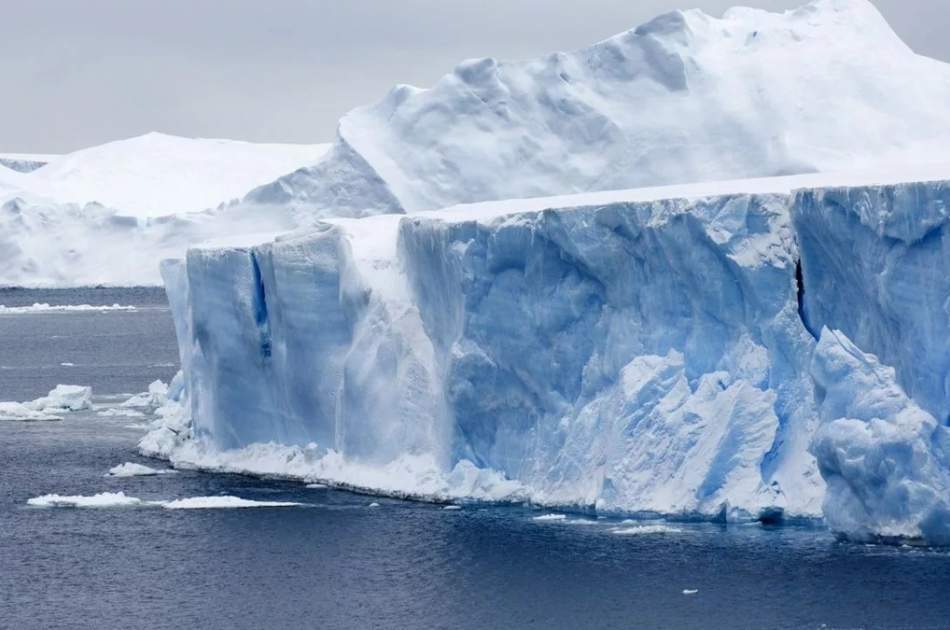Satellite data shows that the world's largest iceberg is moving towards ocean waters after decades of staying put.
Publish dateMonday 4 December 2023 - 10:05
Story Code : 281542
Afghan Voice Agency (AVA): The ships that are traveling in the cold waters near the Antarctic Peninsula these days should regularly check their radar because this frozen mountain named "A23a" has an area of 3,900 square kilometers and It contains "one billion tons of ice". This iceberg had not moved for about 35 years; But now it is moving towards the oceans.
According to Euronews, the "E23E" iceberg has not always held the title of "biggest" and there have been bigger icebergs in the past. For example, the iceberg A-76 (A76) earned this nickname in 2021 after it drifted into the Weddell Sea, but the giant ice soon broke into smaller icebergs and caused Until "E23E" won the position of the largest iceberg.
The origin of this name goes back to 1986, when the front edge of the "Filkner" iceberg broke and created three large icebergs named "A22", "A23" and "A24". In late 1991, the latter became separate icebergs, one of which is the current iceberg.
If icebergs were human, E23E would be a thousand years old now. This iceberg has spent most of its life on land, clinging to a sandy beach in shallow water. Water currents, wind and other factors gradually released this iceberg and moved it.
This caused the iceberg to take a path on the seabed and towards deeper waters in 2020, and in 2022 its movement accelerated.
Scientists say that as the iceberg moves north, it will begin to melt as it reaches warmer air, breaking up and breaking up in the ocean.
Most of the icebergs that come out of the Weddell Sea in the Southern Ocean tend to move slightly northeast of South America.
If that happens to the iceberg, it could drift toward the island of South Georgia in the South Atlantic, home to penguins and seals, and stop ashore there. However, other icebergs, like the similar icebergs, followed a more straight line and moved north towards the Falkland Islands.
Scientists say this iceberg is likely to last longer than other similar icebergs because it came from the colder part of Antarctica and is about 400 meters thick due to heavy snowfall.
If this iceberg is not trapped in shallower and warmer waters, it may move towards southern Africa and the Indian Ocean. This iceberg can even continue its way to the Pacific Ocean and the coast of Chile and go around the globe. "Some of the largest icebergs have done this in the past."
Huge icebergs like this iceberg scrape and wash the sea floor in shallow waters. Because of this, a lot of life that flows at the bottom of the ocean is completely destroyed, and in this sense, it leads to the destruction of the ecosystem.
At the same time, the movement of this iceberg can bring positive results for ocean life. In fact, this part of the Southern Ocean is usually very poor in nutrients, and this iceberg can cause plankton populations to grow by dumping accumulated nutrients from Antarctica and churning up the deep waters.
Although the melting of this iceberg is not directly related to the issue of climate change, however, the news about the movement of the iceberg is published after warm temperatures and low levels of sea ice around Antarctica have been recorded in recent years.
NASA's Earth Observatory says that in February 2023, sea ice around Antarctica reached the lowest extent observed since satellite data began to be recorded in 1979. However, according to this observatory, despite the melting of icebergs in the last few years, the long-term trend of the amount of sea ice in the waters of the South Pole has not changed much, and it is the North Pole that has increased the trend of ice melting in the world's seas.
In any case, the scientists say, knowing about this event will help to make people aware that Antarctica is rapidly losing ice elsewhere, and that "this is a much more serious problem."
According to Euronews, the "E23E" iceberg has not always held the title of "biggest" and there have been bigger icebergs in the past. For example, the iceberg A-76 (A76) earned this nickname in 2021 after it drifted into the Weddell Sea, but the giant ice soon broke into smaller icebergs and caused Until "E23E" won the position of the largest iceberg.
The origin of this name goes back to 1986, when the front edge of the "Filkner" iceberg broke and created three large icebergs named "A22", "A23" and "A24". In late 1991, the latter became separate icebergs, one of which is the current iceberg.
If icebergs were human, E23E would be a thousand years old now. This iceberg has spent most of its life on land, clinging to a sandy beach in shallow water. Water currents, wind and other factors gradually released this iceberg and moved it.
This caused the iceberg to take a path on the seabed and towards deeper waters in 2020, and in 2022 its movement accelerated.
Scientists say that as the iceberg moves north, it will begin to melt as it reaches warmer air, breaking up and breaking up in the ocean.
Most of the icebergs that come out of the Weddell Sea in the Southern Ocean tend to move slightly northeast of South America.
If that happens to the iceberg, it could drift toward the island of South Georgia in the South Atlantic, home to penguins and seals, and stop ashore there. However, other icebergs, like the similar icebergs, followed a more straight line and moved north towards the Falkland Islands.
Scientists say this iceberg is likely to last longer than other similar icebergs because it came from the colder part of Antarctica and is about 400 meters thick due to heavy snowfall.
If this iceberg is not trapped in shallower and warmer waters, it may move towards southern Africa and the Indian Ocean. This iceberg can even continue its way to the Pacific Ocean and the coast of Chile and go around the globe. "Some of the largest icebergs have done this in the past."
Huge icebergs like this iceberg scrape and wash the sea floor in shallow waters. Because of this, a lot of life that flows at the bottom of the ocean is completely destroyed, and in this sense, it leads to the destruction of the ecosystem.
At the same time, the movement of this iceberg can bring positive results for ocean life. In fact, this part of the Southern Ocean is usually very poor in nutrients, and this iceberg can cause plankton populations to grow by dumping accumulated nutrients from Antarctica and churning up the deep waters.
Although the melting of this iceberg is not directly related to the issue of climate change, however, the news about the movement of the iceberg is published after warm temperatures and low levels of sea ice around Antarctica have been recorded in recent years.
NASA's Earth Observatory says that in February 2023, sea ice around Antarctica reached the lowest extent observed since satellite data began to be recorded in 1979. However, according to this observatory, despite the melting of icebergs in the last few years, the long-term trend of the amount of sea ice in the waters of the South Pole has not changed much, and it is the North Pole that has increased the trend of ice melting in the world's seas.
In any case, the scientists say, knowing about this event will help to make people aware that Antarctica is rapidly losing ice elsewhere, and that "this is a much more serious problem."
avapress.net/vdcba8b55rhbwsp.4eur.html
Tags
Top hits












